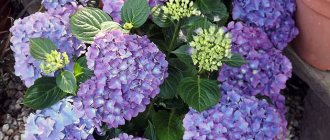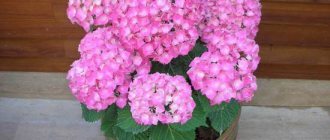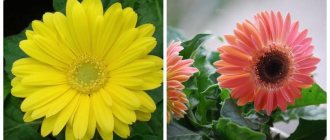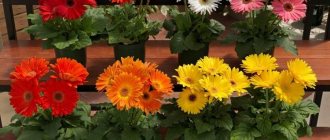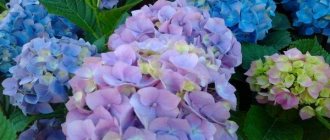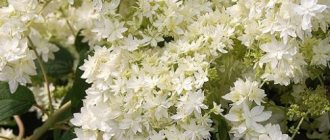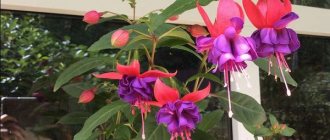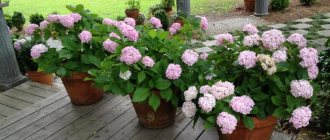Hydrangea is a genus of flowering plants in the hydrangea family. There are about 80 species in this genus, including both shrubs and small trees. In the wild, this plant is found in South and North America, Japan, China and other countries in South and East Asia. The plant was named after one of the princesses of the Holy Roman Empire. And botanical taxonomists gave it the name “hydrangea,” which is translated from ancient Greek as “a vessel with water.” This is due to the fact that the plant loves water very much.
It appeared in European countries in 1820. Currently it is grown in open ground. As soon as it appeared among flower growers and gardeners, experts began to propagate it. Thanks to them, many varieties were created. Today it is a beautifully flowering plant that can be found not only in the garden, but also in a pot on the terrace, veranda or balcony.
Are there indoor hydrangeas?
Growing most garden crops as a houseplant is problematic. To do this, they need to be small, or the owners know how to restrain their growth. They also slowly grew green mass (except for vines), and did not have a very deep and voluminous root system.
Hydrangea only partially meets these requirements. But some varieties of Hydrangea Largeleaf can actually be planted in containers and grown as an indoor flower.
Other indoor species are more affected. Even if they are properly cared for, they usually die during the dormant period and rarely survive until spring.
The plant, which for unknown reasons is called Hydrangea Jasmine, is actually Gardenia. It is united with hydrangea by belonging to the Dicotyledonous class. In botany, such cultures are not even considered related.
How to properly care for hydrangea at home and in the open ground
A beautiful and spectacular flower will decorate any plot of land. Garden hydrangea feels great in our climate, delighting its owners with long-lasting flowering. The main secrets of self-growing, as well as the rules for successful wintering of this non-capricious plant, as well as popular varieties, are discussed in detail in our article.
A luxurious bush with large inflorescences is quite often found in garden plots. Only about 35 species of hydrangea are classified, 12 of which are common in the natural conditions of our country. Active breeding work began more than one and a half hundred years ago. During this time, more than a hundred varieties of hydrangea have been bred, many of which are suitable for home cultivation.
Indoor hydrangea
Growing this flower at home is quite simple. The plant is unpretentious to lighting, but loves moisture very much. The soil should be sufficiently acidic and also well fertilized. Home hydrangea blooms from early spring to autumn; umbrella inflorescences can reach 30 centimeters in diameter.
Most often, the color of the flowers varies from snow-white to bright blue. There is pink hydrangea, as well as with almost burgundy-colored flowers. In the warm season, the plant feels good on balconies and verandas, but it needs to be slightly darkened from direct sunlight.
Large leaf hydrangea
One of the most spectacular garden plants, often growing in the southern regions. The height of an adult bush can reach two meters, and the size of the inflorescences is simply enormous. The main secret to successful cultivation is good shelter in winter. Flowers appear on last year's branches, so you need to take care of their safety in advance.
Preparing hydrangeas for winter in the fall includes laying branches on the ground and carefully covering them with leaves and plastic wrap. There are special varieties that bloom on new shoots, but their size is noticeably inferior to this garden beauty.
Tree hydrangea
This species has gained the most popularity for cultivation. Bright large inflorescences are formed from individual flowers 1.5-2 centimeters in diameter. Color varies depending on the acidity of the soil and the plant variety. Used in group and single plantings, not only the inflorescences are beautiful, but also the oval dark green leaves.
In addition to aesthetic beauty, the flowers of this variety smell great and are excellent honey plants. The most famous among these species is the Anabelle hydrangea. A characteristic feature of the variety are large white inflorescences and a noticeable height of up to three meters.
Ash hydrangea
The main advantage of such a plant is its lush inflorescences with unusual small flower stalks. Wide rounded leaves and a rather impressive height of up to two meters make this option very attractive. Flowering continues from July to the end of August; dried inflorescences serve as an excellent basis for dry bouquets.
Paniculata hydrangea
A characteristic feature of this option is its impressive height. The bushes of this plant reach 2.5 meters in height, and some varieties are trees up to 10 meters with a lush, rounded crown. Flowering is also quite unusual: pyramidal inflorescences, pale greenish in early summer, gradually change color to white, pink and pale purple in late August.
Hydrangea Grandiflora is one of the most attractive varieties of this species, with large inflorescences and excellent hardiness in our climate.
Other popular varieties include: Lime light hydrangea (bright greenish color of inflorescences), Phantom (color changes from soft cream to pale pink) and Vanilla Fraze (cream inflorescences changing color to pronounced crimson).
Hydrangea radiata
Unpretentious varieties of this garden beauty are distinguished by unusual silver leaves with jagged edges. The inflorescences reach 12 centimeters in diameter, which open from early July to late August. The flowering is very lush, and the plant is unusually undemanding in terms of lighting and feeding. If the shoots freeze in winter, the bush quickly recovers. Can be planted in sunny places, tolerates partial shade.
Petiole hydrangea
The plant is a tree-like vine that grows well in suitable conditions. To do this, she needs partial shade and fairly reliable support for growth. This variety blooms for quite a long time in small inflorescences with a pale white or greenish color. Often used in landscape design to design gazebos and decorative arches.
Hydrangea varieties are very numerous and varied. The main value is represented by large inflorescences, the color of which varies from snow-white to deep purple. Depending on the acidity of the soil, flowers can take on different shades, which is often used by gardeners to create beautiful compositions.
Each of the above-described types of this garden plant will decorate your site, and in order for the flowering to please you with its splendor, and the shrub to enjoy its longevity, you need to familiarize yourself with the basic secrets of successful cultivation.
How to care for hydrangea outdoors
Many gardeners consider this plant too capricious, not knowing the basic secrets of successful cultivation. The literal translation of the name of this flower sounds like “a vessel with water,” so the main requirement for growth is abundant watering. The root system is very well developed, so there is no need to worry about waterlogging the soil.
The plant does not like wetlands, preferring loose soil with high acidity. This, by the way, is the second secret to success, so be sure to apply a sufficient amount of fertilizer before planting.
Other nuances of cultivation are discussed below.
Choosing a location and lighting
Many hydrangea varieties tolerate partial shade, but you usually need to choose a space that is well-lit. However, the sun's rays can damage sensitive leaves and flowers, so a wise choice is well-lit places without direct rays.
Soil selection: soil, humus, peat
As mentioned earlier, the acidity of the soil should be quite high. To do this, humus and peat are used in sufficient quantities. Before planting, leaf soil, mulched bark and needles of coniferous trees are also added. This will help organize good drainage and also provide the necessary growing conditions.
Feeding and watering, fertilizer application scheme
The plant really needs regular feeding. To do this, use the following scheme.
Approximate fertilizer application schedule:
- At the first signs of growth in early spring, fertilize with mineral fertilizers (not nitrogen types).
- It is advisable to fertilize the plant twice a month in small portions.
- During the formation of buds, it is necessary to add potassium nitrate, superphosphate or urea to the soil. Watering with the addition of potassium permanganate, as well as spraying the inflorescences with slightly acidified water, works well at this time.
- After flowering has finished, you can feed the plant by spreading compost or rotted manure around the roots.
Watering hydrangeas should be plentiful, always with warm water free of salts and heavy metals. Depending on the type of soil, it is necessary to provide good drainage to avoid root rot.
Planting garden hydrangea
All types of hydrangeas can be used to decorate your garden plot. To do this, you need to choose a well-lit place and dig holes up to half a meter deep. It is necessary to lay out a nutrient mixture of leaf soil, peat and humus on the bottom and sides. If necessary, drainage from bark and expanded clay is introduced, and the soil is mulched.
Immediately after planting, young plants must be well watered and fed regularly. During the first two to three months, suitable minerals should be applied once every two weeks, gradually reducing the amount to one.
As a rule, if the necessary care conditions are met, the plant takes root well in its new location. Some varieties of garden hydrangea bloom in the first year, but you can usually see flowers the following year.
Propagation of hydrangea by cuttings
It is quite easy to grow this plant in your area. To do this, use the method of dividing the bush during spring transplantation. Propagation of hydrangea by cuttings is also a popular method. To do this, take new shoots from the bush, planting them separately from the mother plant.
You can try to get a new bush using layering. To do this, a branch with new buds is bent to the ground and rooted. It is necessary to ensure that part of the shoot with buds is in the ground, after which the new bush is watered abundantly and also fed. Usually, after a year, you can safely replant a new plant, separating it from the mother bush.
There are methods of propagating hydrangea by seeds and grafting, but this is a very lengthy and troublesome process. Want something interesting?
The easiest way to grow a new bush is by dividing the root system, making sure that new buds remain on all parts.
How to cover a hydrangea for the winter
An important part of the necessary care is considered to be high-quality shelter of shoots and preparation for wintering. Despite the fact that most varieties tolerate freezing temperatures well, it is necessary to take care of the safety of the bush in the fall.
It is imperative to cover the hydrangea for the winter using the following technology.
Algorithm of actions:
- Remove leaves and faded inflorescences.
- Branches of bushy varieties must be pulled to the ground, covered with polyethylene and sprinkled with leaves and grass on top. There should be no old leaves left on the ground where pests can overwinter.
- Tree hydrangea needs root cover. Dry leaves, grass and peat are suitable for this. It is necessary to fix polyethylene of sufficient thickness and size on top.
It is necessary to prepare hydrangea for the winter with the correct watering regime. To do this, it is gradually reduced and gradually eliminated. There is also no need to feed the plant in winter. The first feeding should be done after the shoots have fully opened, when the risk of spring frosts has passed.
Sheltering hydrangeas for the winter will ensure the safety of the shoots, while it is also necessary to trim old branches to form the required configuration and size of the bush. This aspect is discussed in more detail below.
Do I need to prune hydrangeas for the winter?
The opinions of gardeners on this issue are divided into diametrically opposed ones. Typically, it is recommended to prune such plants exclusively in early spring to ensure and stimulate good growth. Pruning hydrangeas makes it possible to form a beautiful bush, which is also important.
During the summer period, it is necessary to remove old inflorescences and monitor the condition of the branches. If some have begun to dry out and have lost their attractive appearance, they are also removed from the bush.
How to prune hydrangea correctly:
- The first pruning is carried out in late March - early April. Its goal is to remove shoots damaged during hibernation and renew branches.
- The second pruning is done when the leaf buds open. Minor shortcomings of the first procedure are corrected.
- After the formation of inflorescences, the removal of branches is temporarily stopped so as not to disrupt the flowering process.
- If necessary, old flowers and leaves are removed, and branches are regularly pruned to form a beautiful bush.
Pruning hydrangea in the fall is justified for fast-growing species of this plant, as well as during preparation for the winter period. The bush is inspected, old unnecessary branches are removed, and their length is adjusted. Tree varieties do not need autumn pruning; it is better to carry out these manipulations in early spring.
Caring for hydrangea at home
Indoor varieties of this plant are compact and can bloom for a long time. The choice of soil and placement is fully consistent with the “tastes” of garden flowers. Hydrangea in a pot feels great on southern and eastern window sills; in summer it can be taken out to the balcony.
Watering abundantly, it is very important to regularly spray this moisture-loving plant. After flowering, the pot does not need to be moved to a cool place; the plant’s dormant period passes under normal conditions. Feeding and watering in winter are reduced, and with the onset of spring, the formation of buds can be stimulated with mineral fertilizers.
Hydrangea is replanted every two years, using a larger diameter pot. With proper care, this flower can live up to ten years, regularly delighting its owners with lush blooms.
Hydrangea flowers are quite attractive and also quite varied. In addition to its spectacular appearance, it is easy to maintain.
Caring for hydrangea comes down to abundant watering, mandatory acidification of the soil, and regular pruning.
Hydrangea can also be grown at home, as well as dried winter bouquets can be formed from dried inflorescences. The basic rules for successfully growing this non-capricious plant, as well as visual photos describing popular species, are presented in the information in our article.
uplady.ru
Indoor varieties
Large-leaved hydrangea (Hydrangea macrophylla) is the only species suitable for indoor growing. This is a shrub with straight, weakly branched shoots that do not become woody for a long time. In potted culture it reaches a maximum of 1 m.
The leaves are large, oval, with a sharp crown and jagged edge, bright green. The flowers are collected in corymbs at the tips of last year's shoots. They are usually colored in all shades of pink, but there are red and white varieties.
Two types of whisks:
- small fertile, absent in some cultivars;
- barren large.
When growing hydrangea as a houseplant, you need to choose the right variety.
It must meet the requirements:
- good immunity - the flower will already be in cramped and uncomfortable conditions, a capricious cultivar simply will not survive;
- compact bush;
- height less than 1 meter;
- ability to grow continuously in a small volume of soil;
- beautiful flowers.
The following varieties can be grown as domestic hydrangea:
- Mini Penny grows up to 60-90 cm, the shield is a pink hemisphere 15-20 cm;
- Mireille - rhombic petals, which is clearly visible in the photo, white with a crimson edging and a dot in the center, the bush is the same height as the previous variety;
- Tovelite in a container reaches half a meter or a little more, the corollas look like pink stars, the shields are flattened, with a cross-section of 12 cm;
- Miss Saori produces white double flowers with variable edge colors - from terracotta to pink or crimson;
- The cauldron reaches 40-60 cm, the shields are spherical, up to 25 cm, the corollas are terry, milky with a very pale pink tint, when blooming the buds in the center are lime-colored;
Maculata - in Russia it can only be grown as an indoor crop; it is distinguished by variegated leaves and flat viburnum-shaped inflorescences; lilac fruiting corollas are framed by large, sterile, white ones.
Maculata
Maculata
Tovelit
Mini Penny
Helpful information
Hydrangea domestica is the name of a perennial subshrub. The height of the plant can reach 1 meter, and the flowering period is quite long and lasts from spring to autumn.
The leaves are 10-15 cm long and have an ovoid shape and a serrated edge. The inflorescences are quite large, ball-shaped, reaching up to 35 cm in diameter. The uniqueness of the plant is the ability to change the color of the inflorescences depending on the composition of the soil:
- Sour – blue color.
- Neutral – white/cream shade.
- Alkaline – lilac/pink.
At the same time, the petals of the inflorescences have no color, but the sepals are richly colored, which gives the hydrangea a decorative appearance.
Flowering period
In the garden, the culture blooms buds from July to August. Usually the plant is at its peak for about 1.5 months. But modern remontant varieties have appeared, producing scutes first at the ends of last year’s shoots, then on young growth.
When cared for at home, indoor hydrangea blooms depending on when it had a dormant period. Every year, the crop must rest for at least 70-80 days at a temperature of 0 to +10 ° C, otherwise it will become weak, begin to get sick, and will not bloom.
It is easier to arrange a dormant period for indoor hydrangea in winter. It is transferred to the basement, a frost-free utility room, and placed on a glazed balcony.
When they want to achieve flowering, indoor hydrangea is “awakened”:
- take it out into the sun;
- water with warm water;
- fed.
Soon the bush begins to bloom, and often produces scutes simultaneously with young leaves. When there are several pots, you can “wake up” the plants one at a time.
If old buds are cut off as soon as they lose their decorative properties, and indoor hydrangeas are taken care of well, even non-remontant varieties can sometimes bloom again.
Pink corollas have an unstable color. This means that when special fertilizers or preparations are used, they turn blue or cyan.
Only hydrangeas that produce rounded caps can change color. The varieties of the Japanese group have flat shields; it is useless to water them with special preparations; they will not turn blue anyway.
You can often come across the statement that if wintering is warm, indoor hydrangea will bloom next time in the cold season. Maybe. When the owners are able to arrange a period of rest with a decrease in temperature to 5-10 ° C in the summer or early autumn. If the plant is simply not allowed to rest, it will most likely wither and die.
Brief description of cultivation
- Bloom . It starts in April and ends in November.
- Illumination . The light should be bright, but at the same time diffused. To do this, it is enough to place the bush near a south-facing window (at a distance of 200–300 cm).
- Temperature regime . During the growing season - about 20 degrees, and during the dormant period - from 7 to 10 degrees.
- Watering . During the summer months, the bushes need plenty of frequent watering. In spring and autumn, water more rarely and moderately. During the dormant period, the soil is moistened rarely and sparingly.
- Humidity . Requires high air humidity. On hot days, the bush should be moistened as often as possible with a spray bottle.
- Fertilizer . Feeding is carried out during the period February–October. To do this, use a mineral complex for flowering plants (heathers, azaleas and rhododendrons), and apply fertilizer to the soil twice a month. In winter, the plant does not need fertilizer.
- Rest period . Observed in December and January.
- Transplant . It is carried out only for indoor hydrangea every year, and its life expectancy is from 3 to 4 years.
- Trimming . In the autumn, when the bushes have faded, weakened stems must be cut off, and powerful shoots must be shortened by ½ part of the length. With the onset of spring, cut out any weak stems that have become very elongated during the dormant period.
- Reproduction . By cuttings, dividing the bush and seed method.
- Pests . Spider mites and aphids.
- Diseases . Downy mildew and gray mold.
What to do with a flower after purchase
Caring for hydrangea at home begins with quarantine. The plant should be kept separate from the main collection for 2 weeks so as not to become a carrier of diseases or pests.
Next, most sources recommend replanting your indoor hydrangea. This is a good idea. Moreover, peat in pots is often not ordinary sour, but exhausted, left over after growing cut flowers, impregnated with unknown preparations and with an unknown acidity.
Definitely needs to be transplanted:
- non-blooming hydrangea purchased at a sale;
- transfer the hydrangea with buds and a good, healthy root into a large pot (minimum 5 liters) without disturbing the coma.
If the substrate is sour or spoiled, the underground part is rotting, soil pests are detected, a complete transplant of the indoor hydrangea is performed. Flowers will have to be sacrificed.
Types of home hydrangea with photos
Only large-leaved hydrangea (Hydrangea macrophylla), which is also called garden hydrangea, is grown indoors. And also many of its varieties are used for this (more than a hundred).
Varieties with cream and white inflorescences:
- M-me E. Mouillere . The inflorescences reach from 18 to 20 centimeters in diameter, and the flowers are 20–60 mm. This plant differs from other varieties in its narrower foliage.
- Souer Tharese . An early-flowering low-growing bush reaches a height of 35 to 40 centimeters. The inflorescences consist of flowers of regular shape, and in diameter they reach from 15 to 17 centimeters.
Varieties with pink inflorescences:
- Goliath . The late-flowering plant reaches a height of 0.6 to 0.7 m. Rich pink large inflorescences reach about 30 centimeters in diameter. The edge of the sepals is deeply cut.
- Hamburg . The plant has a height of 0.35–0.4 m. The diameter of the inflorescences reaches 16–18 centimeters, and they consist of pink flowers with a diameter of 40–50 mm.
- Europe . The height of the luxuriantly flowering bush is 0.4–0.5 m. The diameter of the inflorescences is 20–25 centimeters, and the diameter of the flowers is about 60 millimeters.
Varieties with red inflorescences:
- Red sensation . Inflorescences are reddish-burgundy. If you add iron salts to the substrate, then they will turn burgundy-violet.
- Prima . This plant belongs to the medium-flowering varieties, and its height is from 20 to 25 centimeters. Small flowers in diameter, reaching 35 mm, are collected in small inflorescences (15–18 centimeters in diameter).
Varieties with blue inflorescences:
- Early Blue . This vigorous plant is decorated with deep blue inflorescences.
- Ramars Mars . The compact bush has inflorescences up to 20 centimeters in diameter. Gradually, the edges of the petals turn greenish.
Types and varieties of Hydrangeas. Which Hydrangeas are best to grow at home?
Home care
The plant is uncomfortable indoors, so its maintenance cannot be called simple. But if all the requirements of the culture are met and the substrate is selected successfully, the bush will be able to grow and bloom indoors for years.
Lighting and temperature
Hydrangea is a short-day plant. Large-leaved plants suffer from excess sun more than other species, and they are grown indoors.
The flower needs 6-10 hours of light per day. It is better to place hydrangea on a western windowsill. In the south or east, the bush will have to be shaded.
Culture doesn't like heat. In summer it requires cool keeping; it is undesirable for the temperature to rise above 20° C. Spraying and airing will not help make the life of hydrangea more comfortable.
During the rest period, a temperature of 8-10° C is recommended. It can drop to 0° C, and according to some reports, be -5° C, but it is better not to risk it.
Without a cool rest for 2.5-3 months, indoor hydrangea may not bloom.
Watering and air humidity
Hydrangea is a well-known water plant, which is reflected in the name of the plant. During the growing season, the soil should be constantly moist. During rest periods, irrigation is reduced.
Hydrangea does not tolerate watering with hard water. It needs:
- filter;
- to defend;
- freeze;
- boil.
At least once a month, the flower must be watered with acidified water.
Air humidity should be high at all times. Simply spraying hydrangea daily is not enough; bowls of water are placed next to the flower, the pot is placed on wet pebbles, in a pot with wet sphagnum.
Feeding
Hydrangea is fertilized every 10-14 days constantly, except for the dormant period. It is better to buy specialized preparations for hydrangea or indoor conifers.
If the owners are going to change the color of the flower, you can not buy specialized fertilizer, but additionally feed:
- iron sulfate;
- alum;
- aluminum sulfate;
- boric acid.
Trimming and shaping
The operation is performed immediately after the scutes wither. If flowering, which is the norm for indoor conditions, occurs in spring or early summer, short pruning stimulates the formation of new branches. By the end of the season they will get stronger, and after a period of rest they will release buds.
But, if the peak of decorativeness occurs in mid-summer or autumn, it’s not worth the risk. Only the shield itself is removed, without touching the bracts, which are often not visible under the hydrangea’s cap. It is from their axils that new inflorescences are likely to appear next season.
In spring, it is recommended to thin out overgrown indoor hydrangeas. At ground level, cut off any weak or thin stems.
If there are too many strong shoots, some are removed - this way the hydrangea will not waste energy and plastic substances on their maintenance, the caps increase in size and last longer.
Diseases and treatment
Hydrangeas rarely get sick. But with improper care and weakened immunity, the plant can be affected by fungal or bacterial diseases and be attacked by pests.
The main problems when growing hydrangea:
- if hydrangea is kept in too humid and shaded conditions, then powdery mildew (a fungal disease) may form on the plant;
- in very dry and hot weather (more than +27 ° C), hydrangea can be affected by spider mites;
- in extreme heat (more than +30 °C), hydrangea can shed its leaves; if the sun is too strong, the leaves begin to turn yellow; the flowers dry out and wither;
- on alkaline soils (excess lime, pH value more than 8), hydrangea develops chlorosis - yellowing of leaves;
- if there is insufficient air and soil humidity, hydrangea stops blooming, the leaves dry out, and the roots may dry out;
- With poor drainage and excessive watering, the roots begin to rot, and as a result, fungal diseases form.
Table: hydrangea problems and their solutions
| Problem | Cause | Solution |
| Flowers and shoots wither | Roots are flooded or there are gnawing pests in the soil | If there is no drainage, the plant needs to be urgently replanted and the soil replaced: Check the roots and, if necessary, cut off rotten ones. Treat with Fitosporin or other fungicide. Dry the roots without watering for several days. Then water according to the usual pattern. If the hydrangea has not been watered, check the soil for the presence of pests (they are clearly visible in the soil after watering). Treat the soil with Grom-2. |
| The leaves turn yellow and fall off. The leaf itself is yellow, the veins are green, then it dries | Chlorosis - from excess lime in the soil, too bright light and lack of iron in the soil. | Move the plant to diffused light, you can even remove it from the windowsill. Measure the acidity of the soil; if it is above 8 Ph, it needs to be replaced. Do not water hydrangea with hard water with too much lime. Feed the plant with iron chelate: dissolve 4 grams of iron sulfate in a liter of filtered (or distilled) warm water, add 2.5 grams of citric acid |
| The leaves are drying at the edges | Lack of moisture | Ensure timely watering, spray the plant in the morning with warm boiled water without sediment |
| Spots appear on the leaves. A whitish coating on the leaves, then holes form in place of the spots and plaque | Fungal or bacterial disease. Whitish coating - powdery mildew | Treat with a fungicide (for example, Chisloflor + Fitolavin) in three doses every week. Check whether the maintenance conditions comply with the necessary standards: temperature, humidity, watering, lighting. Feed with complex fertilizer |
| Hydrangea doesn't bloom | The plant did not have a period of winter dormancy. Temperature too high | Place the hydrangea in the coolest, least sunny location. Spray with the addition of an immunostimulant (Epin, Zircon) and feed with fertilizer with phosphorus: 2g Superphosphate per 1 liter of water. 7-8 drops of Epin are enough for 1 liter |
| Too spacious container for roots | Repot in a smaller pot that matches the size of the root system. | |
| The trunk began to turn black at the bottom | Black leg - rot from stagnation of water + low temperatures | Take healthy cuttings and root to preserve the variety. Check the root system and soil. If there are healthy roots, then the plant can be saved. Remove anything blackened and rotten and replace the soil. Treat the plant, especially the roots, with Fitosporin (paste) and an immunostimulant. For 1 liter of water, paste on the tip of a teaspoon and 7-8 drops of stimulant. Spray the leaves and shoots with nitrogen fertilizer + Fitosporin + green soap: half a teaspoon of ammonia + paste on the tip of a teaspoon + a teaspoon of green soap per 1 liter of water. Additionally, treat with Metronidazole (Trichopol), alternating products: 1 tablet per liter of water. Carry out treatments 2 times a week |
| Shoots dry out and break | The root system is overdried | To wet the earthen ball, pour the earth in several stages. Trim off dried shoots. Do not allow the soil to dry out and spray the plant. Do not drain the water from the pan; pour gravel, expanded clay or coarse perlite into it and add water when it dries. |
| There are growths on the leaves, white “fluff”, cobwebs | Presence of pests: growths - scale insects; white "fluff" - mealybug; cobwebs - mite | Treat with a comprehensive pest control product. Scale insects and scale insects must first be cleaned off, then the plant must be sprayed with the preparation |
| Leaves have holes, flower buds wither and fall off, leaves and shoots wither | Pests: weevil, aphid | Treat with a pest control product. For example, Fitoverm, Bitoxibacillin |
| There are visible passages from microworms on the leaves. | The soil is infected with nematodes | Treat the soil and leaves with Nematophagin. It is advisable to replace the soil (after replanting, treat it two or three times for prevention) |
| The leaves have circular or multi-colored spots. Leaves wither and become deformed | Viral disease | Insects are carriers of viruses. Check the flower for their presence, remove the affected parts of the plant. Treat the soil and plant for two months 2 times a week with the following composition: Phytolavin on the tip of a teaspoon + 8 drops of Epin + one dose of ExtraFlorN1 + Boric acid on the tip of a knife per 1 liter of water. First, dilute boric acid - it is diluted only in water with a temperature of more than 40 ° C. This complex is antiviral, pest repellent, fungicidal and immunostimulating. The plant must be kept in quarantine separately from others; if there are no signs of cure, it will have to be destroyed, the soil thrown away, and the pot treated with boiling water. |
To prevent fungal and bacterial diseases, add a bio-product based on beneficial bacteria to the soil when watering 1-2 times a month: Gamair, Rizoplan (Planriz), Alirin-B.
Video: diseases and pests of hydrangea
How to replant at home
This is the most important element of caring for potted hydrangea. The operation is carried out every 2-3 years and differs from transplanting ordinary indoor flowers. It is better if it is done using the transshipment method, without destroying the earthen clod:
- Drainage is placed in the new pot and a little fresh substrate is added.
- Place a hydrangea in the center.
- The free space is filled with soil.
- Compact and water.
If the root rots or the substrate has deteriorated, there is a high probability that after completely replacing the soil and stripping the lower shoots, the hydrangea will not take root in the flowerpot, but will begin to wither and die. It is better to plant in open ground.
Choosing a pot
The container needs a regular shape, with bottom holes. If a smaller volume is not indicated in the variety description, for a developed bush it should be at least 5 liters. For a young plant or cuttings, 2-3 liters will be enough.
With each transplant, the size of the pot of indoor hydrangea is increased by 1.5 times, and not by 2-3 cm, as for other crops. When the container is needed too large, the bush is divided into parts or transferred to the garden.
What kind of soil does potted culture like?
This is where the problems begin. Hydrangea needs a soil acidity of 5-5.5, and in store-bought mixtures, even if the required numbers are indicated on the package, the pH is usually kept at 6-6.5.
It is better to prepare the substrate yourself:
- sour peat – 2 parts;
- pine litter or litter – 2;
- completely rotted humus – 1;
- sand – 0.5.
In the future, you will have to buy a device to measure soil acidity. Without this, indoor hydrangea will not live long - the pH level changes over time due to watering and fertilizers. It may need to be stabilized with acidified water or special preparations.
Selection, planting and propagation of hydrangea
All news › Flowers › February 26, 2012
Narcissus is rightfully considered a spring flower. But if you like it, you can admire it and inhale the wonderful aroma almost all summer. Just like some of our readers do.
First find out, then start
My first hydrangea (paniculata) was given to me by my neighbors in the country. I prepared everything best for her, the best place - in the sun, the best soil - I added humus and ash to the soil, and also fertilized it constantly. I really hoped that in the middle of summer the flower would thank me and throw out lush caps of flowers. But it was in no hurry to grow; the ovaries actually appeared in July - small, I could barely see them. And then they completely withered away. Something was wrong with my hydrangea, as if it was missing something. I couldn’t understand what exactly.
I still had to read special literature and learn more about the nature of hydrangea.
I realized my mistake immediately as soon as I found out how the name of the flower is translated from ancient Greek: “hydrangea” means “water and vessel.” Water! That's what she was missing. This flower is constantly thirsty. And the second mistake is fertilized soil: hydrangea loves acidic soils and cannot tolerate lime, but I also added ash out of great love, which only deacidified the soil.
In fact, choosing a hydrangea is not a tricky matter; the main thing in the growing process is to approach planting and cultivation correctly. And you can grow gorgeous flowering hats by following our advice and the advice of our readers. Hydrangea, both indoor and garden, is not a particularly demanding plant and, with proper propagation and care, will delight you with beautiful flowers for many weeks.
I had to correct mistakes. I transplanted the flower into a shady place where the sun only occasionally peeks, added humus and some mineral fertilizers to the hole for the flower, and to acidify the soil, watered it with a solution of sulfuric acid (1 tsp per 10 liters of water). I shortened the branches of my stunted hydrangea and transplanted the bush to a new place. Now the flower appreciated my efforts, but I saw the result only the next summer. In July, the side branches gave good growth, the crown formed in the form of a ball, and the inflorescences at the ends of the branches formed a flowering ball. Now it is the pride of my garden. This is how hydrangea taught me a lesson for life: first learn the habits of the plant, then plant it.
Is it possible to plant indoor hydrangea in the summer in the country?
Don't be afraid, plant it. You can make acidic soil yourself, just bring soil from a swampy place. It is advisable to feed the bush periodically. But in the fall it needs to be replanted in a pot, and after the first frost, taken home again. Those who have basements keep hydrangea there; those who don’t, a place under the bathroom or a dark corridor will do. The soil needs to be watered only occasionally: in winter, hydrangea “rests”. In February, place it on the window, start spraying it with water and watering it. By May you will receive large inflorescences, and you can take the plant to the country again. Hydrangea tolerates replanting well in bloom, but, of course, with a clod of soil. And don’t forget to give her something to drink “from the heart.”
Comments on the article:
Add a comment
our-gardens.ru
Reproduction methods
Indoor hydrangea is easy to propagate vegetatively:
- Cuttings - the 7-10 cm long shoot tips remaining after pruning can be rooted in water or perlite. Often they produce buds without even having time to produce lower shoots. The first inflorescences must be removed immediately.
- Divide the bush when an indoor hydrangea requires a pot that is too large.
- It is inconvenient to plant layering in a container, but some amateurs succeed. Only the branch needs to be secured well.
It is almost impossible to obtain your own hydrangea seeds indoors. They are bought, scattered at the end of winter on the surface of a light substrate, and covered with glass. Keep at high humidity and temperature 22-25° C in the light.
General transplant rules
The first transplant of a houseplant is forced; it is carried out immediately after purchase.
Hydrangea indoor transplant after purchase
The main rule during this period is a thorough examination of the root system for the presence of mealybugs, which often infect the crop. Additionally, the condition of the roots is analyzed: rotten areas are cut off, and the remaining healthy shoots are pre-treated with a weak pink solution of potassium permanganate (potassium permanganate).
The remnants of the temporary soil mixture in which the hydrangea grew are removed by soaking in water for 0.5 hours.
A mandatory requirement for planting is the organization of a drainage layer. Expanded clay in the form of balls or a crushed mixture is suitable.
The transshipment method is recommended. Technology:
- the soil is dried for 3-4 days;
- the work surface is lined with plastic film or paper, the flower pot is placed in the center, the plant is tilted and removed, taking it by the base;
- leave the remains of the earthen lump on the roots without shaking them off much;
- drainage with a thickness of 3 cm or more is laid on the bottom; chopped sphagnum or neutral peat can be placed on it;
- the soil is poured in a layer of about 1-2 cm, a flower is placed in the central part and sprinkled with soil mixture to the required level, the root collar is placed flush with the ground, buried no lower than the distance at which the hydrangea was previously in the substrate, otherwise there is a risk of stem rotting;
- the soil is not compacted so as not to damage the nearby root system;
- the plant is sprayed and placed in a permanent place of growth, and the next day it is fully watered;
- the surface of the substrate can be sprinkled with a thin layer of peat mixture to prevent rapid evaporation of moisture.
Problems when growing at home
The plant rarely gets sick, but can be colonized:
- whitefly;
- mealybug;
- spider mite;
- aphids;
- thrips.
The flower suffers if care for indoor hydrangea is incorrect:
- the plates turn yellow due to chlorosis or low acidity of the substrate;
- leaves turn black - watering with cold water, root rotting due to acidification of the soil;
- tips dry - dry air or soil;
- brown spots appear - most likely, insufficient watering;
- light marks on the plates – excess sun;
- slow growth – nutritional deficiency.
Varieties of large-leaved hydrangea by flower color
There are a huge number of varieties of large-leaved hydrangea. Let's look at a few of the most popular ones, dividing them into color categories.
Light
Sister Therese (Soeur Therese):
- inflorescence diameter 30 cm;
- white inflorescences with a delicate lilac-pink tint change color to greenish-pink towards the end of flowering;
- blooms until September on last year's shoots;
- dense, spreading shrub.
The inflorescences of the Sister Teresa variety reach 30 cm in size
Madame Emile Mouillere:
- inflorescence diameter 20 cm;
- flowers, pure white at the beginning of flowering, then acquire light pink or light blue shades;
- blooms profusely on shoots of last and this year until October;
- leaves are narrower than other varieties.
Variety Madame Emile Mulievo, during flowering, like true French women, does not forget about changing the colors of her outfits
Blue
Early Blue:
- inflorescence diameter 30 cm;
- blue inflorescences with blue-violet hues initially have a greenish color;
- blooms profusely until October on shoots of the previous and current year;
- has a strong root system and compact bush.
The variety Airlie Blue pleases with flowering until October
Nikko Blue:
- inflorescence diameter 30 cm;
- the inflorescences are bright blue; to maintain the color, an acidic soil reaction of 5.5–7.0 pH is required;
- abundant flowering until September - October on the shoots of the current and last year;
- fast-growing medium-sized shrub.
The inflorescences of the Niko Blue variety can compete with the sky blue in brightness
Pink
Ramars Mars or Mars:
- inflorescence diameter 30 cm;
- pink-crimson inflorescences with a white edge, which turns green over time;
- blooms until September on shoots of the current and previous year;
- compact bush.
The bushes of the Ramars Mars (Mars) variety are compact, but the inflorescences are gigantic
Miss Saori:
- inflorescence diameter 18 cm;
- inflorescences are matte white with a pink border, retain their original color regardless of the acidity of the soil;
- blooms until September on shoots of the current and previous year;
- dark green foliage has a purple tint.
The Miss Saori variety has original colors not only of flowers, but also of leaves
You and my love (You&me Love):
- stem height 100 cm;
- blooms continuously from May to September;
- in alkaline soil it is colored pink. in acidic, with a high content of aluminum - in blue;
- leaves are resistant to powdery mildew;
- frost resistance -29 °C.
The frost-resistant variety You and My Love was developed quite recently - in 2015
Reds
Admiration:
- inflorescence diameter 20 cm;
- flowers are bright red;
- abundant flowering until October on last year's shoots;
- the bush has a dense crown.
The Delight variety blooms profusely even in October
Multicolor
Bavaria:
- inflorescence diameter 20 cm;
- lime-colored flowers with a violet-blue center and a white border;
- abundant flowering until October on last year's shoots;
- compact bush.
Variety Bavaria - a real extravaganza of colors and shades
Hot Red:
- inflorescence diameter 15 cm;
- red flowers with high acidity of the soil have a purple tint;
- blooms until October on last year's shoots;
- The bush is lush and does not become prone to massive inflorescences.
Red flowers of the Hot Red variety acquire a purple tint when the soil is highly acidic
Schloss Wackerbarth:
- inflorescence diameter 30 cm;
- pink inflorescences with a blue center and green edging, green at the beginning of flowering;
- flowering on last year's shoots until October-early November;
- flowers are decorated with light stamens.
Huge inflorescences, colorful petals, graceful stamens - all this is the Schloss Wackerbart variety
Beginning gardeners often look for the “hydrangea mix” variety. You should know that there is no such variety; this phrase refers to multi-colored hydrangeas in a composition or in a store’s assortment.
